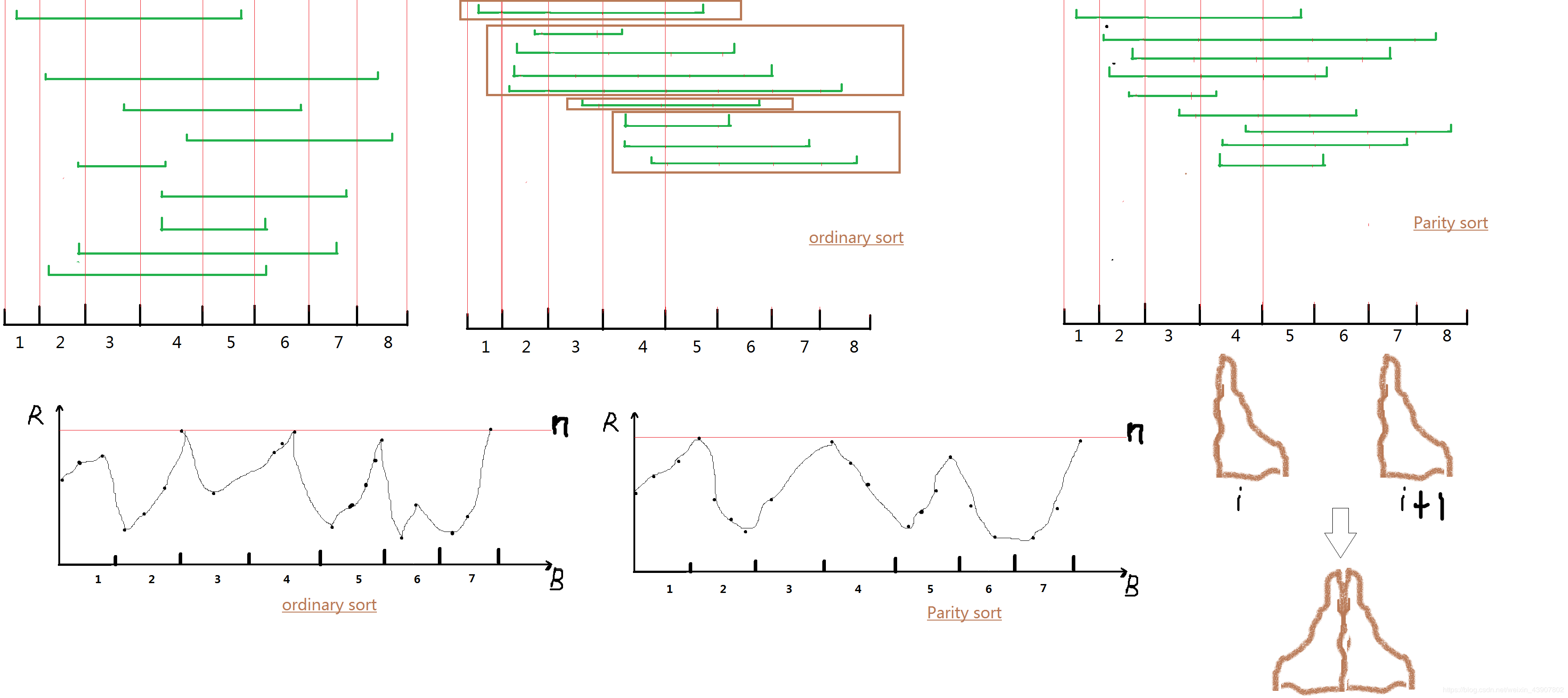莫队算法及各种变体(持续更新)
简单介绍
博客安利:
解决一类离线区间查询问题,分块思想,时间复杂度(O(nsqrt n))
-
排序
读入的时候对整个数组进行分块,块大小一般使用(sqrt n),对询问操作排序的时候,先以块号为第一关键字,(r)为第二关键字,从小到大排序,然后逐个遍历
离线后将询问排序,顺序处理每个询问,暴力从上一个区间的答案转移到下一个区间的答案(通过两个指针的(++)和(--)操作实现)
-
指针移动

当(l)指针从绿色区域向右移动一格,更新操作对应,先减去cnt[绿色]的共享,cnt[绿色](--),再加上cnt[绿色]区域的贡献,其他指针移动操作类似。
基础莫队
-
给出n只袜子颜色,每次给个区间([l,r]),询问这个区间连续取两只袜子取到同一种颜色的概率。
-
思路:
对于L,R的询问。
设其中颜色为x,y,z的袜子的个数为a,b,c..…
那么答案即为 ((a*(a-1)/2+b*(b-1)/2+c*(c-1)/2....)/((R-L+1)*(R-L)/2))
化简得: ((a^2+b^2+c^2+...x^2-(a+b+c+d+.....))/((R-L+1)*(R-L)))
即: ((a^2+b^2+c^2+...x^2-(R-L+1))/((R-L+1)*(R-L)))
我们需要解决的一个问题是:求一个区间内每种颜色数目的平方和。
-
AcCode:
#include <iostream>
#include <cmath>
#include <algorithm>
using namespace std;
typedef long long LL;
const int maxn=5e4+5;
//存储询问区间
struct node{int l,r,id;LL A,B;}q[maxn];
//in[]存储每个数所在的区间
int n,m,a[maxn],in[maxn];
//处理前预排序
inline bool cmp(node& a,node& b){
return in[a.l]==in[b.l]?a.r<b.r:a.l<b.l;
}
//处理完,返回原来询问的顺序
inline bool CMP(node& a,node& b){return a.id<b.id;}
//cnt[]存储每个数的个数
int ans,cnt[maxn];
LL pow(LL x){return x*x;}
inline void update(int x,int d){
ans-=pow(cnt[a[x]]),cnt[a[x]]+=d,ans+=pow(cnt[a[x]]);
}
inline void solve(){
int l=1,r=0;
for(int i=1;i<=m;++i){
while(l<q[i].l)update(l,-1),l++;
while(l>q[i].l)update(l-1,1),l--;
while(r<q[i].r)update(r+1,1),r++;
while(r>q[i].r)update(r,-1),r--;
if(l==r){q[i].A=0,q[i].B=1;continue;}
q[i].A=ans-(r-l+1);
q[i].B=1LL*(r-l+1)*(r-l);
LL gc=__gcd(q[i].A,q[i].B);
q[i].A/=gc,q[i].B/=gc;
}
}
int main(){
cin>>n>>m;
int sqr=sqrt(n);
for(int i=1;i<=n;++i)cin>>a[i],in[i]=i/sqr+1;
for(int i=1;i<=m;++i)cin>>q[i].l>>q[i].r,q[i].id=i;
sort(q+1,q+1+m,cmp);
solve();
sort(q+1,q+1+m,CMP);
for(int i=1;i<=m;++i)
printf("%lld/%lld
",q[i].A,q[i].B);
return 0;
}
奇偶排序优化
博客安利: https://oi-wiki.org/misc/mo-algo/ , https://www.cnblogs.com/WAMonster/p/10118934.html
奇数块中r从小到大排序,偶数块中r从大到小排序(第一块的快数为1,且初始(l=1,r=0),在(r)指针从小到大向右跳的时候,正好处理完第一块的询问,此时(r)位于第一块中(r)最大值的地方,接下来处理偶数块,即第二块,偶数块中(r)为从大到小排序,第二块中的第一个询问正好是第二块中的(r)的最大值)。
主要原理便是右指针 跳完奇数块往回跳时在同一个方向能顺路把偶数块跳完,然后跳完这个偶数块又能顺带把下一个奇数块跳完。理论上主算法运行时间减半,实际情况有所偏差。
这种优化能让程序快30%左右,据说每个点平均优化200ms

inline bool cmp(node& a, node& b) {
return (belong[a.l] ^ belong[b.l]) ? belong[a.l] < belong[b.l] : ((belong[a.l] & 1) ? a.r < b.r : a.r > b.r);
}
指针移动的常数优化
运用运算符优先级知识,把
void add(int pos) {
if(!cnt[aa[pos]]) ++now;
++cnt[aa[pos]];
}
void del(int pos) {
--cnt[aa[pos]];
if(!cnt[aa[pos]]) --now;
}
和这个
while(l < ql) del(l++);
while(l > ql) add(--l);
while(r < qr) add(++r);
while(r > qr) del(r--);
硬生生压缩成这个:
while(l < ql) now -= !--cnt[aa[l++]];
while(l > ql) now += !cnt[aa[--l]]++;
while(r < qr) now += !cnt[aa[++r]]++;
while(r > qr) now -= !--cnt[aa[r--]];
但是并不是每一次莫队的使用都能这样压缩,视实际情况而定。
带修莫队
类比普通莫队,引入第三关键字“修改时间”, 表示当前询问是发生在前Time个修改操作后的。也就是说,在进行莫队算法时,看看当前的询问和时间指针(第三个指针,别忘了l,r)是否相符,然后进行时光倒流或者时光推移操作来保证答案正确性。 (O(unit*n+n2/unit+(n/unit)2*n)) ,(unit=n^{2/3})时,取最小为(O(n^{5/3})).
题目链接:
给定n个颜色,m条指令(含修改和查询)
- (Qquad lquad r) 询问颜色种数
- (Rquad posquad y) 将pos位置的颜色修改为(y)
RE代码:
//加减代替取模优化,多数组结构体优化,puts()输出优化,自带换行
#include <bits/stdc++.h>
using namespace std;
#define fre freopen("data.in","r",stdin);
#define frew freopen("sol.out","w",stdout);
#define ms(a) memset((a),0,sizeof(a))
#define go(i, a, b) for(register int i=(a);(i)<(b);++(i))
#define rgo(i, a, b) for(register int i=(a);(i)>(b);--(i))
#define re(i, a, b) for(register int i=(a);(i)<=(b);++(i))
#define rre(i, a, b) for(register int i=(a);(i)>=(b);--(i))
#define all(x) (x).begin(),(x).end()
#define pb push_back
#define lson l,m,i<<1
#define rson m+1,r,i<<1|1
#define reg register
typedef long long LL;
const int inf = (0x7f7f7f7f);
inline void sf(int &x) {
x = 0;
int w = 0;
char ch = 0;
while (!isdigit(ch)) {
w |= ch == '-';
ch = getchar();
}
while (isdigit(ch)) x = (x << 3) + (x << 1) + (ch ^ 48), ch = getchar();
x = (w ? -x : x);
}
inline void pf(int x) {
if (x < 0) putchar('-'), x = -x;
if (x > 9) pf(x / 10);
putchar(x % 10 + '0');
}
const int maxn = 10003;
struct query{
int l,r,tim,id,bk,ans;
}q[maxn];
struct change{
int pos,nw,od;
}c[maxn];
int now[maxn],a[maxn];
int n,m,T,t,tim;
char op;
int ans;
int cnt[maxn];
inline bool cmp(const query& a,const query& b){
return a.bk==b.bk?(a.r==b.r?(a.tim<tim):((a.bk&1)?a.r<b.r:a.r>b.r)):a.l<b.l;
}
inline bool CMP(const query& a,const query& b){
return a.id<b.id;
}
inline void push(int x,int d){
ans+=(cnt[x]==0);
++cnt[x];
}
inline void pop(int x,int d){
ans-=(cnt[x]==1);
--cnt[x];
}
inline void solve(int x,int y,int l,int r){
if(l<=x&&x<=r)pop(a[x],1),push(y,1);
a[x]=y;
}
int main() {
//fre;
sf(n),sf(m);
int x,y,unit;unit=sqrt(n);
re(i,1,n)sf(a[i]);
re(i,1,m){
//cin>>op>>x>>y;
scanf(" %c %d %d",&op,&x,&y);
//cout<<op<<x<<y<<endl;
if(op=='Q')q[++t]=query{x,y,T,t,x/unit+1};
else c[++T]=change{x,y,now[x]},now[x]=y;
}
int l=1,r=0;
sort(q+1,q+1+t,cmp);re(i,1,t){
//cout<<q[i].l<<' '<<q[i].r<<endl;
while(tim<q[i].tim)solve(c[1+tim].pos,c[tim+1].nw,l,r),tim++;
while(tim>q[i].tim)solve(c[tim].pos,c[tim].od,l,r),tim--;
while(l<q[i].l)pop(a[l],1),l++;
while(l>q[i].l)push(a[l-1],1),l++;
while(r<q[i].r)push(a[r+1],1),r++;
while(r>q[i].r)pop(a[r],1),r--;
q[i].ans=ans;
}
sort(q+1,q+1+t,CMP);
//cout<<"t :"<<t<<endl;
re(i,1,t)pf(q[i].ans),putchar('
');
return 0;
}